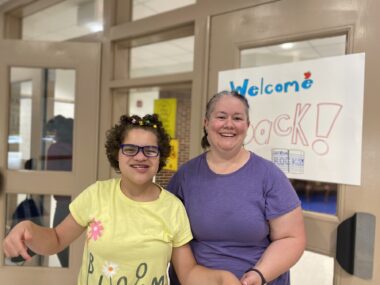How maximizing parent-teacher relationships benefits my Angel
A columnist shares 3 strategies for shaping a productive partnership

While packing up my 13-year-old Angel, Juliana, the other day, I realized how fortunate we are to have a great start to her seventh-grade year in school. Juliana has been cooperative at school, and the fussing and crying that usually ensue in the mornings have lessened dramatically.
I’m not under any illusion that Juliana’s great start is all my doing. I’ve done our usual back-to-school transition with a few tweaks. But we also have great support at her school, including her classroom teacher, Ms. Corn.
This is Juliana’s second year in Ms. Corn’s classroom. She is one of those teachers you instantly love. She’s diligent but laid-back, which, in my opinion, is a good fit for Juliana’s tantrums and hyperactivity due to Angelman syndrome. Ms. Corn is not easily rattled.
We’ve been fortunate throughout the years to have some amazing teachers. Two of them received the coveted distinction as Teacher of the Year. The other day, I told Ms. Corn that I feel a third Teacher of the Year in our midst. As an educator myself, I know that not every teacher will be like Ms. Corn. Still, I use the same strategies I have throughout the years to maintain a strong partnership with her and the support staff.
Following are three strategies that help me maintain that relationship.
Strategy 1: Knowing how to say no
Even with the best teacher, there may be times that you disagree. Each year at Juliana’s individualized education program (IEP) review meeting, I make sure that I have read the teacher’s notes and additions.
There have been times when I disagreed with an activity that Juliana wasn’t ready for or a task that I felt shouldn’t be a goal. When this happens, I kindly express my disagreement and ask how we could modify the activity. I’ve heard many horror stories about IEP meetings, and my husband and I try to avoid confrontations even when we disagree — which leads to strategy number two.
Strategy 2: Addressing problems quickly
Juliana started middle school last year, which was a big transition for her. All things considered, it was a good transition. However, Ms. Corn and I had a lot of communication about Juliana’s behavior. Most of the challenges stemmed from hormonal changes that are normal during puberty. I let Ms. Corn know what we were doing at home to address some of the concerns we would see in her daily notes.
It’s still early, but we are not seeing those issues this year. I was shocked and relieved the other day when Ms. Corn said, “She’s a model student in the class.”
Strategy 3: Deferring to her professionalism
As a parent, I may know my child well, but there’s a lot I don’t know. Sometimes I need to listen to and trust her teacher. It doesn’t mean I throw my hands in the air and turn a blind eye. However, there are times when I need to trust Ms. Corn’s judgment.
Last year, for example, I was concerned about Juliana crying on the way to school. I asked Ms. Corn if anything abnormal was happening. She assured me that it wasn’t and even sent pictures of a happy Juliana during a classroom activity.
Ms. Corn was right. Whatever was bothering Juliana leveled off and is completely different this year. The other day, when I picked Juliana up from school, she kissed and hugged Ms. Corn so many times I had to make her stop.
Working with Juliana’s teachers and support staff is truly a team effort. I don’t have all the answers and neither do they. With a collective effort, though, we pack a really big punch.

Juliana and Ms. Corn finish another great day at school. (Photo by Sabrina L. Johnson)
Note: Angelman Syndrome News is strictly a news and information website about the disease. It does not provide medical advice, diagnosis, or treatment. This content is not intended to be a substitute for professional medical advice, diagnosis, or treatment. Always seek the advice of your physician or other qualified health provider with any questions you may have regarding a medical condition. Never disregard professional medical advice or delay in seeking it because of something you have read on this website. The opinions expressed in this column are not those of Angelman Syndrome News or its parent company, Bionews, and are intended to spark discussion about issues pertaining to Angelman syndrome.








Leave a comment
Fill in the required fields to post. Your email address will not be published.